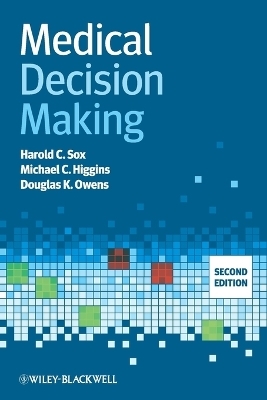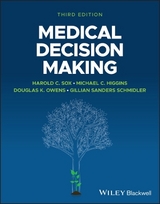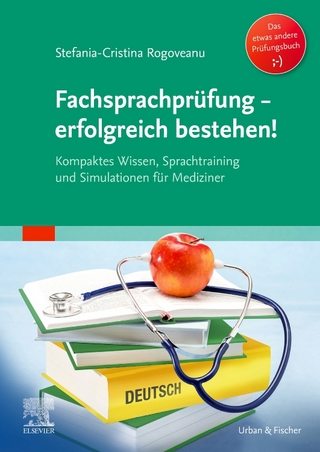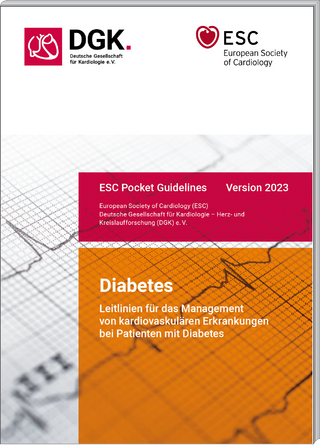
Medical Decision Making
Wiley-Blackwell (Verlag)
978-0-470-65866-6 (ISBN)
- Titel erscheint in neuer Auflage
- Artikel merken
Medical Decision Making provides clinicians with a powerful framework for helping patients make decisions that increase the likelihood that they will have the outcomes that are most consistent with their preferences.
This new edition provides a thorough understanding of the key decision making infrastructure of clinical practice and explains the principles of medical decision making both for individual patients and the wider health care arena. It shows how to make the best clinical decisions based on the available evidence and how to use clinical guidelines and decision support systems in electronic medical records to shape practice guidelines and policies.
Medical Decision Making is a valuable resource for all experienced and learning clinicians who wish to fully understand and apply decision modelling, enhance their practice and improve patient outcomes.
“There is little doubt that in the future many clinical analyses will be based on the methods described in Medical Decision Making, and the book provides a basis for a critical appraisal of such policies.” - Jerome P. Kassirer M.D., Distinguished Professor, Tufts University School of Medicine, US and Visiting Professor, Stanford Medical School, US
Harold C. Sox Geisel School of Medicine at Dartmouth, Hanover, New Hampshire Michael C. Higgins Stanford University, Stanford, California Douglas K. Owens Department of Veterans Affairs Palo Alto Health Care System, Palo Alto, California; Stanford University, Stanford, California
Foreword xi
Preface xv
1 Introduction 1
1.1 How may I be thorough yet efficient when considering the possible causes of my patient’s problems? 1
1.2 How do I characterize the information I have gathered during the medical interview and physical examination? 2
1.3 How do I interpret new diagnostic information? 5
1.4 How do I select the appropriate diagnostic test? 5
1.5 How do I choose among several risky treatment alternatives? 6
1.6 Summary 6
2 Differential diagnosis 7
2.1 Introduction 7
2.2 How clinicians make a diagnosis 8
2.3 The principles of hypothesis-driven differential diagnosis 11
2.4 An extended example 21
Bibliography 26
3 Probability: quantifying uncertainty 27
3.1 Uncertainty and probability in medicine 27
3.2 Using personal experience to estimate probability 34
3.3 Using published experience to estimate probability 46
3.4 Taking the special characteristics of the patient into account when estimating probability 57
Problems 58
Bibliography 59
4 Understanding new information: Bayes’ theorem 61
4.1 Introduction 61
4.2 Conditional probability defined 64
4.3 Bayes’ theorem 65
4.4 The odds ratio form of Bayes’ theorem 69
4.5 Lessons to be learned from Bayes’ theorem 76
4.6 The assumptions of Bayes’ theorem 82
4.7 Using Bayes’ theorem to interpret a sequence of tests 84
4.8 Using Bayes’ theorem when many diseases are under consideration 88
Problems 90
Bibliography 91
5 Measuring the accuracy of diagnostic information 93
5.1 How to describe test results: abnormal and normal, positive and negative 93
5.2 Measuring a test’s capability to reveal the patient’s true state 98
5.3 Howto measure the characteristics of a diagnostic test: a hypothetical case 106
5.4 Pitfalls of predictive value 109
5.5 Sources of biased estimates of test performance and how to avoid them 110
5.6 Spectrum bias 116
5.7 Expressing test results as continuous variables 125
5.8 Combining data from several studies of test performance 134
Problems 137
Bibliography 140
6 Expected value decision making 143
6.1 An example 145
6.2 Selecting the decision maker 148
6.3 Decision trees: structured representations for decision problems 149
6.4 Quantifying uncertainty 152
6.5 Probabilistic analysis of decision trees 156
6.6 Expected value calculations 158
6.7 Sensitivity analysis 161
6.8 Folding back decision trees 163
Problems 168
Bibliography 168
7 Markov models and time-varying outcomes 170
7.1 Markov model basics 170
7.2 Exponential survival model and life expectancy 189
Problems 198
Appendix: Mathematical details 200
Bibliography 203
8 Measuring the outcome of care – expected utility analysis 204
8.1 Basic concept – direct utility assessment 205
8.2 Sensitivity analysis – testing the robustness of utility analysis 210
8.3 Shortcut – using a linear scale to express strength of preference 212
8.4 Exponential utility – a parametric model 213
8.5 Exponential utility with exponential survival 218
8.6 Multidimensional outcomes – direct assessment 220
8.7 Multidimensional outcomes – simplifications 223
8.8 Multidimensional outcomes – quality-adjusted life years (QALY) 228
8.9 Comparison of the two models for outcomes with different length and quality 232
Problems 235
Appendix: Mathematical details 237
Bibliography 242
9 Selection and interpretation of diagnostic tests 243
9.1 Taking action when the consequences are uncertain: principles and definitions 244
9.2 The treatment-threshold probability 247
9.3 The decision to obtain a diagnostic test 252
9.4 Choosing between diagnostic tests 259
9.5 Choosing the best combination of diagnostic tests 261
9.6 Setting the treatment-threshold probability 263
9.7 Taking account of the utility of experiencing a test 275
9.8 A clinical case: test selection for suspected brain tumor 279
9.9 Sensitivity analysis 281
Bibliography 287
10 Cost-effectiveness analysis and cost–benefit analysis 288
10.1 The clinician’s conflicting roles: patient advocate, member of society, and entrepreneur 288
10.2 Cost-effectiveness analysis: a method for comparing management strategies 291
10.3 Cost–benefit analysis: a method for measuring the net benefit of medical services 298
10.4 Measuring the costs of medical care 301
Problems 304
Bibliography 305
11 Medical decision analysis in practice: advanced methods 307
11.1 An overview of advanced modeling techniques 307
11.2 Use of medical decision-making concepts to analyze a policy problem: the cost-effectiveness of screening for HIV 311
11.3 Use of medical decision-making concepts to analyze a clinical diagnostic problem: strategies to diagnose tumors in the lung 323
11.4 Use of complexmodels for individual-patient decisionmaking 330
Bibliography 333
Index 337
| Erscheint lt. Verlag | 22.7.2013 |
|---|---|
| Verlagsort | Hoboken |
| Sprache | englisch |
| Maße | 155 x 236 mm |
| Gewicht | 494 g |
| Themenwelt | Medizin / Pharmazie ► Medizinische Fachgebiete |
| ISBN-10 | 0-470-65866-5 / 0470658665 |
| ISBN-13 | 978-0-470-65866-6 / 9780470658666 |
| Zustand | Neuware |
| Informationen gemäß Produktsicherheitsverordnung (GPSR) | |
| Haben Sie eine Frage zum Produkt? |
aus dem Bereich



